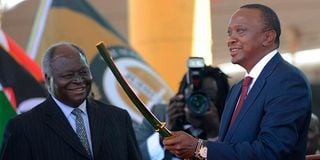Kenya’s political eclipse: Part II

Kenya's fourth president Uhuru Kenyatta receives a sword as a symbol of authority from his predecessor Mwai Kibaki (left) during his inauguration at the Moi International Sports Center Kasarani in Nairobi on April 9, 2013.
On this Sunday, I offer you the second instalment in my four-part series on Kenya’s political eclipse. My purpose is to stoke public intercourse about Kenya’s stunted political and economic growth, which has become an existential threat to the state.
Today, I focus my piece on the construction of Kenya as a republic of fear. In spite of bursts of resistance when pushed to the wall, the Kenyan people are largely docile when faced with state tyranny.
It’s this docility and submission to proto-fascists that has held the country back. Kenyans have blinked every time they’ve come to the precipice of true liberation. They settle and compromise on mediocrity, and often worse. We are definitely a country of cowards.
First, I want to stipulate that all colonised societies suffer a form of psychoses of self-hate. Perhaps no continent has suffered more from colonial pogroms than Africa. It’s here where the White Man enjoyed the deepest penetration of our souls and bodies. He rendered many of us into zombies.
Just look around you. We carry strange European names that we can’t even pronounce. Our people, especially women, are in love with fake European hair. This hair pornography, as I’ve called it, is a testament to the rejection of our negritude.
Brainwashed and intellectually defeated, we long abandoned our African spiritualities. We worship alien European, Jewish, and Arab gods. It’s these traumas that make us easy prey for the dictator.
Liberal state
At independence in 1963, the honeymoon between the new black African government and the people didn’t even last two years. The Independence Constitution attempted to impose a form of a liberal state but it was a sad cynical exercise, a cruel ploy by the colonialists.
The economy was left fully yoked to the British monarchy, then still an empire. Left with a few scraps on the table for the “natives” to share, Mzee Jomo Kenyatta immediately embarked on the creation of an ethnocracy to consolidate his personal rule. He took a hammer to the residual wobbly ramparts of what passed for a liberal constitution. Like the imperial British before him, he decided that Kenyan blacks were natives, not citizens.
Mzee Kenyatta systematically dismantled virtually all the commanding tenets of a liberal society. In their place, he revived the colonial republic of fear in which obedience and subservience to the state became the watchwords of the new republic. Gone by the boards was any pretence of a free-thinking citizenry or a democratic zeitgeist among the people.
I remember one particular incident of that era. I was in Form Six at Alliance High School when Attorney-General Charles Njonjo, whom I believe was the Chair of Governors of the school, graced the prize-giving day in 1978. Rather than rejoice, we were all gripped by fear and trepidation at his presence. I was a student Senator but even I wasn’t at ease.
I remember freezing when called up to accept several academic prizes. A joyful moment became a long minute of fright. Why? That’s because we knew the state wasn’t ours, and that AG Njonjo and other senior state officers were enemies of the people. In contrast, I remember the joy with which we received President Barack Obama at the State University of New York in Buffalo in 2013. The contrast couldn’t be clearer.
Here was the world’s most powerful human mobbed by an exuberant university community. Juxtapose that against Mr Njonjo, an African potentate of a cruel and beggarly post-colonial state, and you get the picture. In 1978, Kenya’s political bone marrow was already baked in the oven of dictatorship.
So, we trace Kenya’s republic of fear to the rise of illiberalism under Mzee Kenyatta and his destruction of liberal norms, the evisceration of dissent within Kanu, and the abolition de facto of the opposition. In 1978, when Mzee Kenyatta passed on, Vice-President Daniel arap Moi ascended to the presidency by the miracle of accident.
Timid and unsteady at first, Mr Moi turned into a bear soon after realising that he was president with imperial draconian powers. He learnt that his word was law. After the abortive coup of 1982, Mr Moi became the embodiment of fear and dictatorship. In many areas, he made Mzee Kenyatta look like a novice. He perfected the politics of repression and fear.
Excesses of power
President Moi’s two successors — Mwai Kibaki of Narc/PNU and Uhuru Kenyatta of Jubilee — were both less draconian because of their nature and the constraints of the 2010 Constitution. Still, both engaged at times in unspeakable excesses of power. But their attempts to thwart the constitution were often rebuffed by the courts. Enter UDA’s William Ruto in 2022.
Mr Ruto, a man who bitterly opposed the 2010 Constitution, is a political animal in his own league. Already, he’s brought back Mr Moi’s totalitarian tactics. Unless he’s checked, Kenya could easily become another North Korea. Next Sunday, in Political Eclipse Part III, I look at the end of democracy.
Makau Mutua is SUNY Distinguished Professor and Margaret W. Wong Professor at Buffalo Law School, The State University of New York. @makaumutua.





